Datebook: Poignant paintings at the Autry, powerful collage and the vintage photographs of a pot botanist
- Share via
A painter who fused the European and the indigenous and a collagist who constructs the identities of black girls. L.A. has lots going on this week. Here’s what we’ve got in our Datebook:
Rick Bartow, “Things You Know but Cannot Explain,” at the Autry Museum of the American West. This is the first comprehensive exhibition devoted to the late Oregon-born painter, a member of the Mad River band of Wiyot. Bartow developed a career as an artist later in life — after his service in the Vietnam War and a period contending with PTSD. On the canvas, he found inspiration, drawing from historic and contemporary European and Native American artistic traditions to create a fusion of something new: haunting and totemic images of creatures who channel grief and frailty. Opens Saturday and runs through Jan. 6. 4700 Western Heritage Way, Griffith Park, Los Angeles, theautry.org.
Deborah Roberts, “Fragile but Fixable,” at Luis De Jesus Los Angeles Projects. Based in Texas, the artist is known for creating collages out of found photographs, paintings and drawings. These often depict black girls entering adolescence, evoking moments of drama, strength and joy. It is Roberts’ first solo show in Los Angeles. Opens Saturday at 6 p.m. and runs through June 16. 2685 S. La Cienega Blvd., Culver City, luisdejesus.com.

Aline Mare, “Requiem for Acker,” at Beyond Baroque. Mare has created a series of works inspired by a poem on the last page of Kathy Acker’s final published book, “Eurydice in the Underworld,” in which the author dealt with her cancer through the tales of Greek mythology. Mare, who was close to Acker at the time of her death, incorporates items that once belonged to the author in multimedia pieces that dwell on the body, disease and mortality. Through May 27. 681 N. Venice Blvd., Venice, beyondbaroque.org.
David Donald Sutherland and Chas Schroeder, “Affinity and Distance,” at Chimento Contemporary. This two-person show features the work of a pair of emerging young artists who employ paint in distinct, yet complementary ways. There is Sutherland, who creates smooth, super-flat surfaces consisting of crisp pools of paint. Schroeder, in the meantime, mixes material and technique, creating abstractions that feature solid blocks of acrylic color against bits of spray and transparent, watery shades. This will be the last exhibition at the gallery at its current location. This summer, Chimento is relocating to West Adams. Opens Friday at 4 p.m. and runs through June 16. 622 S. Anderson St., No. 105, Boyle Heights, Los Angeles, chimentocontemporary.net.
Mel Frank, “When We Were Criminals,” at M + B Photo. Back in the ’70s, Mel Frank helped write the literal book on how to grow pot: the 1978 manual “Marijuana Growers’ Guide Deluxe.” He also took a lot of pictures — of the harvest, of plants, of buds, of the botanical processes necessary to cultivate cannabis. This exhibition is the first to bring together the work of this California botanist, writer and photographer whose cannabis cultivation guides served as bibles of weed way before there were such things as private equity firms focused on cannabis. Through June 9. 1050 N. Cahuenga Blvd., Hollywood, www.mbphoto.com.
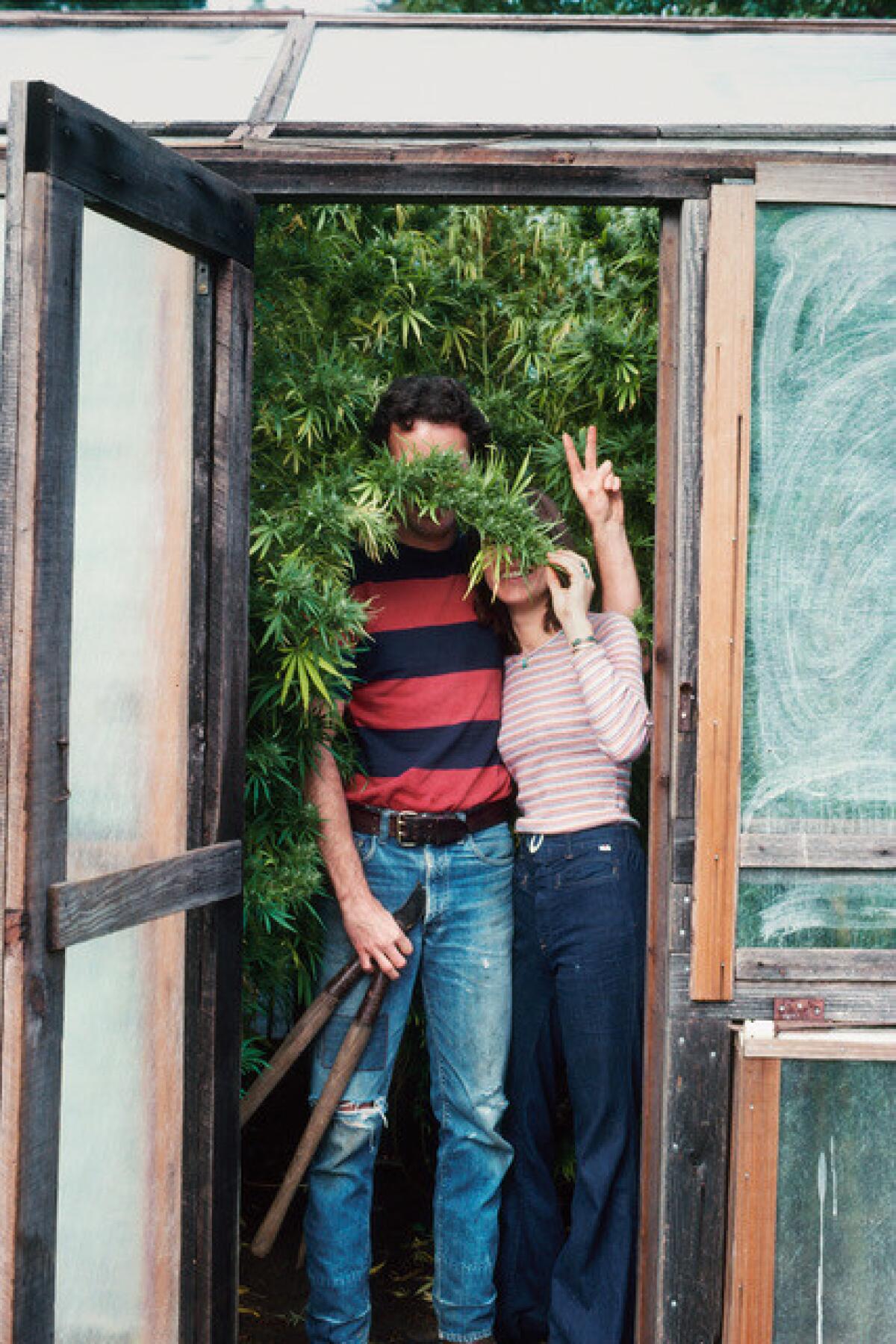
Yoshua Okón, at François Ghebaly. In his first solo exhibition at the gallery, Okón, who hails from Mexico City and is known for weaving fact and fiction into works that touch broadly on politics and history, is presenting two video installations and a series of drawings. This includes his 2015 piece “Oracle,” which centers on protesters rallying against unaccompanied child migrants from Central America, as well as “The Indian Project: Rebuilding History,” also from 2015, that looks at how the Maine town of Skowhegan adopted an American Indian identity and name despite having no Native Americans in its midst. Through May 26. 2245 E. Washington Blvd., downtown Los Angeles, ghebaly.com.
Pop-Up magazine, at the Theatre at the Ace Hotel. The storytelling show is back in Los Angeles this weekend with presentations from SoCal’s very own taco historian Gustavo Arellano, author Leanne Sharpton, photographer Lauren Greenfield (who recently showed her “Generation Wealth” pictures at the Annenberg Space for Photography) and television comedy writer Bess Kalb. Saturday at 7:30 p.m. 929 S. Broadway, downtown Los Angeles, popupmagazine.com.
“Forest for the Trees,” at the Lancaster Museum of Art and History. A series of five exhibitions looks at the symbiotic relationship between humans and trees — tracking relationships both positive and negative. This includes paintings by Constance Mallinson and Greg Rose and a collaboration between Osceola Refetoff and Christopher Langley (known as High & Dry) that features images and words devoted to open spaces and the often destructive ways in which they are used. Opens Saturday and runs through July 15. 665 W. Lancaster Blvd., Lancaster, lancastermoah.org.
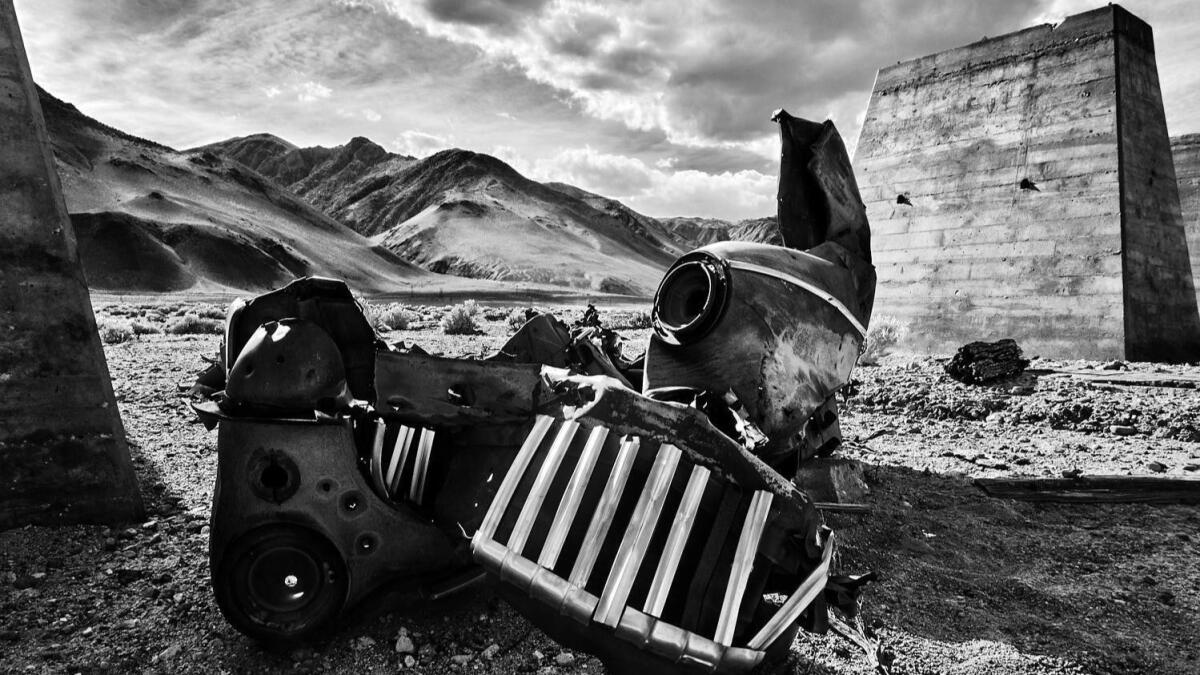
LAST CHANCE
“Force of Nature,” at Steve Turner. A group show featuring six international artists from Los Angeles presents paintings and video that employ landscape to explore current events such as immigration, environment and technology, among other themes. This includes artists from Los Angeles (Eddie Rodolfo Aparicio, Nick Farhi and John Knuth), Paris (Émilie Broute & Maxime Marion), Cologne (Lukas Marxt) and New York (Glen Baldridge). Through Saturday. 6830 Santa Monica Blvd., Hollywood, steveturner.la.
Peter Shire, “Drawings, Impossible Teapots, Furniture & Sculpture,” at Kayne Griffin Corcoran. The key post-Modern artist, ceramicist and designer, associated with the Milan-based Memphis school of design, has a new solo show on view at Kayne Griffin Corcoran, his first presentation at the gallery. The show will bring together drawings, sculpture, furnishings and the ceramics for which he is so well known. Through Saturday. 1201 S. La Brea Ave., Mid-Wilshire, Los Angeles, kaynegriffincorcoran.com.

Karen Margolis, “Garden of Mutei,” at Garis & Hahn. In her first solo exhibition at the gallery, the Brooklyn-based artist is showing large, intricate paper works that serve as maps of thought and synapse. She achieves her geometric patterns by cutting, painting and collaging, with thread, fragments of maps and other elements. Through Saturday. 1820 Industrial St., downtown Los Angeles, garisandhahn.com.
Adrián Villar Rojas, “The Theater of Disappearance,” at the Museum of Contemporary Art. The artist, born in Argentina and known for installations that transform spaces — and often play on themes of the apocalyptic — is taking over MOCA’s Little Tokyo space with an installation that employs the architecture and technologies of Hollywood special effects to create an environment that responds to a “post-human world dominated by technology.” Through Saturday. Geffen Contemporary, 152 N. Central Ave., downtown Los Angeles, moca.org.
“Muse: Mickalene Thomas,” and “tête-à-tête,” at Pomona College Museum of Art. This show explores two aspects of Thomas’ work: the muses that have inspired her work and the artists with whom she finds kinship. The first part gathers the artist’s photography of herself, her mother, her friends and lovers — images that inspire and serve as the basis of her work. The latter part features an installation curated by Thomas that features work by artists she finds inspiring, including Deana Lawson, Zanele Muholi and LaToya Ruby Frazier. Through Saturday. 330 N. College Ave., Claremont, pomona.edu/museum.
Dora De Larios, “Other Worlds,” at the Main Museum. Over a long-running career, the Los Angeles-born ceramic artist created work that fused the modern with the Mexican and the Japanese. The downtown museum has inaugurated a new gallery space with a survey of the late artist’s work — De Larios died in January — bringing together whimsical sculpture, graceful dishware and the elegant plates she crafted especially for a White House lunch in the 1970s. Through Sunday. 114 W. 4th St., downtown Los Angeles, themainmuseum.org.
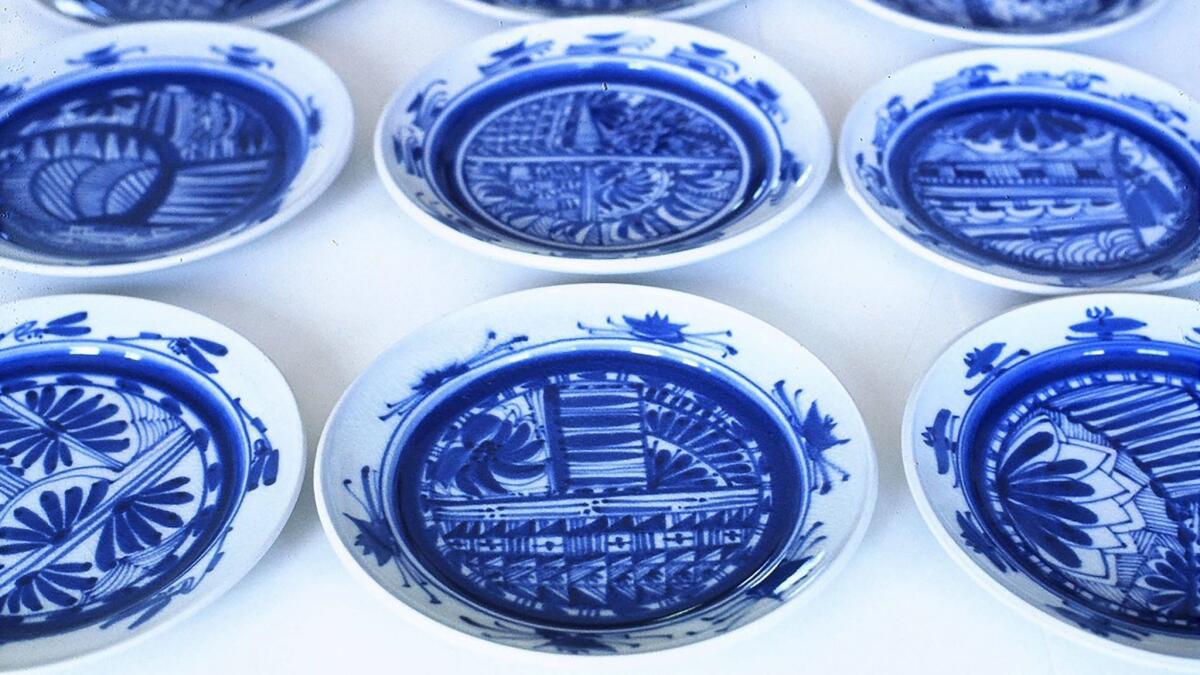
Rigo 23, “Ripples Become Waves,” at the Main Museum. This show by the L.A.-based artist Rigo 23 highlights the case of Leonard Peltier, a member of the American Indian Movement who received a life sentence in connection with the shooting deaths of two FBI agents in 1975. On view is a sculpture of Peltier that the artist made for American University’s campus in 2017, an impressive, large-scale work that was subsequently (and controversially) removed. Through Sunday. 114 W. 4th St., downtown Los Angeles, themainmuseum.org.
“Unspeakable: Atlas, Kruger, Walker,” at the Hammer Museum. The museum has installed videos by three artists — Charles Atlas, Barbara Kruger and Kara Walker — known for the ways they wield art as social critique. This includes works that ruminate on the nature of life, generosity, the body and violence. Through Sunday. 10899 Wilshire Blvd., Westwood, Los Angeles, hammer.ucla.edu.
Jasper Johns, “ ‘Something Resembling Truth,’ ” at the Broad museum. An exhibition created in collaboration with the Royal Academy in London will feature more than 120 paintings, sculptures, prints and drawings by the celebrated 20th century artist associated with the early days of the Pop movement. The show traces his six-decade career through a series of themed installations that examine the stages of his work, as well as the innovative ways in which he employed materials such as encaustic, collage and other media. The show includes many works that have never been seen before in Los Angeles — a real treat. Through Sunday. 221 S. Grand Ave., downtown Los Angeles, thebroad.org.
ONGOING
Folkert de Jong, “Cathedra,” and Nathan Redwood, “After Tin Man,” at Denk Gallery. This two-person show features sculptures by Dutch artist Folkert de Jong (his first solo show in Los Angeles in more than a decade) and work by L.A.-based painter Nathan Redwood. The two exhibitions were developed separately — De Jong’s sculptural figures dwell on the grotesque while Redwood’s paintings take on portraiture, landscape and still life — but work in tandem. Through May 19. 749 E. Temple St., downtown Los Angeles, denkgallery.com.

Rashid Johnson, “The Rainbow Sign,” at David Kordanksy. In his latest show at Kordanksy, Johnson has taken over all three gallery spaces with a show that takes symbols of national identity and looks at what it might mean to be free of them. A series of wall sculptures also contain objects and books that are laden with meaning for the artist (such as a copy of James Baldwin’s “The Fire Next Time”). These pieces were employed at the opening in readings and performances by invited poets and musicians, including playwright Ntozake Shange. Through May 19. 5130 W. Edgewood Pl., Mid-Wilshire, Los Angeles, davidkordanskygallery.com.
Chris Kraus, “In Order to Pass,” at Chateau Shatto. The celebrated author of “I Love Dick” was a filmmaker before she became a writer. This exhibition focuses on that work — namely, the nine films she made in the 1980s and ’90s, experimental works that dwell on feminism, historical themes and relationships. Through May 19. 1206 S. Maple Ave., Ste. 1030, downtown Los Angeles, chateaushatto.com.
Geta Brătescu, “The Leaps of Aesop,” at Hauser & Wirth. The 92-year-old Romanian conceptualist’s first show in Los Angeles consists of more than 50 works drawn from throughout different periods of her career — all inspired by the Greek fabulist Aesop. The artist regards Aesop as a mischievous figure, a symbol of “everything that stood against totalitarianism,” and one who parallels the subversive characters in Romanian folk tales. In her own work, she uses play and other inventive approaches to material to convey these and other ideas. Through May 20. 901 E. 3rd St., downtown Los Angeles, hauserwirthlosangeles.com.
Mark Bradford, “New Works,” at Hauser & Wirth. The gallery is showing a suite of new works by the Los Angeles painter, who continues his process of creating abstraction through collaging, tearing, painting and layering. The new works, which employ comic books in their fabrication, pack a visceral punch. Through May 20. 901 E. 3rd St., downtown Los Angeles. hauserwirthlosangeles.com.
Alison Saar, “Topsy Turvy,” at L.A. Louver. This show of new work by the L.A.-based artist takes the character of Topsy, from Harriet Beecher Stowe’s “Uncle Tom’s Cabin” as a point of inspiration. In sculpture and painting, she transforms the young slave girl into a symbol of defiance and, in the process, weaves in elements of Greek myth into Topsy’s story. An essential show.Through May 25. 45 N. Venice Blvd., Venice, lalouver.com.

SPOT, “American Myths Violated & Realities Revealed,” at Cornelius Projects. A musician who was also engineer and producer at the punk label SST Records, SPOT (born Glen Lockett) captured a culture in flux with his camera: California hippies, beach bums, bohemians, skaters and rockers and punks. The exhibition gathers images made in the ’60s and ’70s.Through May 26. 1417 S. Pacific Ave., San Pedro, corneliusprojects.com.
“It Passes Like a Thought,” at the Beall Center for Art + Technology. Seven contemporary artists engage with the human obsession with birds — species studied by armies of ornithologists, linguists and musicologists, and devotedly followed by equally large armies of birders. Artists such as Victoria Vesna and Susan Silton explore birdsong, while Lynn Aldrich and Juan Fontanive look at flight. Other installations mechanize bird movement. Through May 26. 712 Arts Plaza, UC Irvine, Irvine, beallcenter.uci.edu.
Francesca Gabbiani, “Vague Terrains and Urban F____,” at Gavlak. In Gabbiani’s first solo show at the gallery, she is focused on the idea of non-places: those transitional, interstitial, marginally abandoned sites that seemingly belong to everyone and no one: old staircases, partly abandoned urban sites, empty lots. Using carved and colored paper, she records these banal and quotidian spots. Through May 26. 1034 N. Highland Ave., Hollywood, gavlakgallery.com.

Fay Ray, “I am the House,” at Shulamit Nazarian. In her first solo exhibition at the gallery, the Los Angeles-based artist is presenting sculpture and photography that channel an interest in female identity and the fetishization of objects — objects crafted out of eggs, corn and dried flowers that toy with notions of birth, death and life. Through May 26. 616 N. La Brea Ave., Hancock Park, Los Angeles, shulamitnazarian.com.
“March of Eyes,” at Cirrus Gallery. Centered around a new series of Cirrus prints by L.A. artist Math Bass, the show also gathers pieces by five emerging artists who address issues such as perspective and viewership in their work. Through May 26. 2011 S. Santa Fe Ave., Los Angeles, cirrusgallery.com.
Raúl Cordero, “The Seer’s Suite,” at Edward Cella Art & Architecture. A series of cinematic paintings are inspired by Cordero’s interactions with clairvoyants — drawing from his sessions, but also from his dreams. The resulting images are gauzy and ghostly. Through May 26. 2754 S. La Cienega Blvd., Culver City, edwardcella.com.
“Palmyra: Loss and Remembrance,” at the Getty Villa. Once home to some of the finest Roman-era ruins in the world, Palmyra made headlines when elements of the ancient site were destroyed by Islamic State militants during their occupation of the site in 2015. This exhibition features objects from the area, including ancient funerary sculpture on loan from other institutions, as well as engravings and photographs from the Getty Research Institute’s private collection. Through May 27. 17985 Pacific Coast Highway, Pacific Palisades, getty.edu.
“Inhabit: the Olmsted Brothers at Palos Verdes Peninsula,” at the Palos Verdes Art Center. In the early 20th century, a consortium of businessmen that invested in land on the Palos Verdes Peninsula invited the Olmsted Brothers landscape architecture firm (their father designed Central Park), to create a Mediterranean oasis there. The brothers began their project by undertaking a profound study of the area. This exhibition gathers many of their materials: drawings, topographic maps, studies of flora and fauna. A historic look at the Los Angeles of a century ago. Through May 27. 5504 W. Crestridge Road, Rancho Palos Verdes, pvartcenter.org.
“Paper Promises: Early American Photography,” at the Getty Museum. As the United States expanded throughout the 19th century, and news of the Civil War racked the nation, there was a growing demand for images that were easy to reproduce and distribute — hence the turn from daguerreotypes to paper photography. This exhibition looks at some of the earliest examples of the medium, an important period of experimentation that included mournful battlefield imagery and regal portraiture, including notable images of Abraham Lincoln. Through May 27. 1200 Getty Center Drive, Brentwood, Los Angeles, getty.edu.
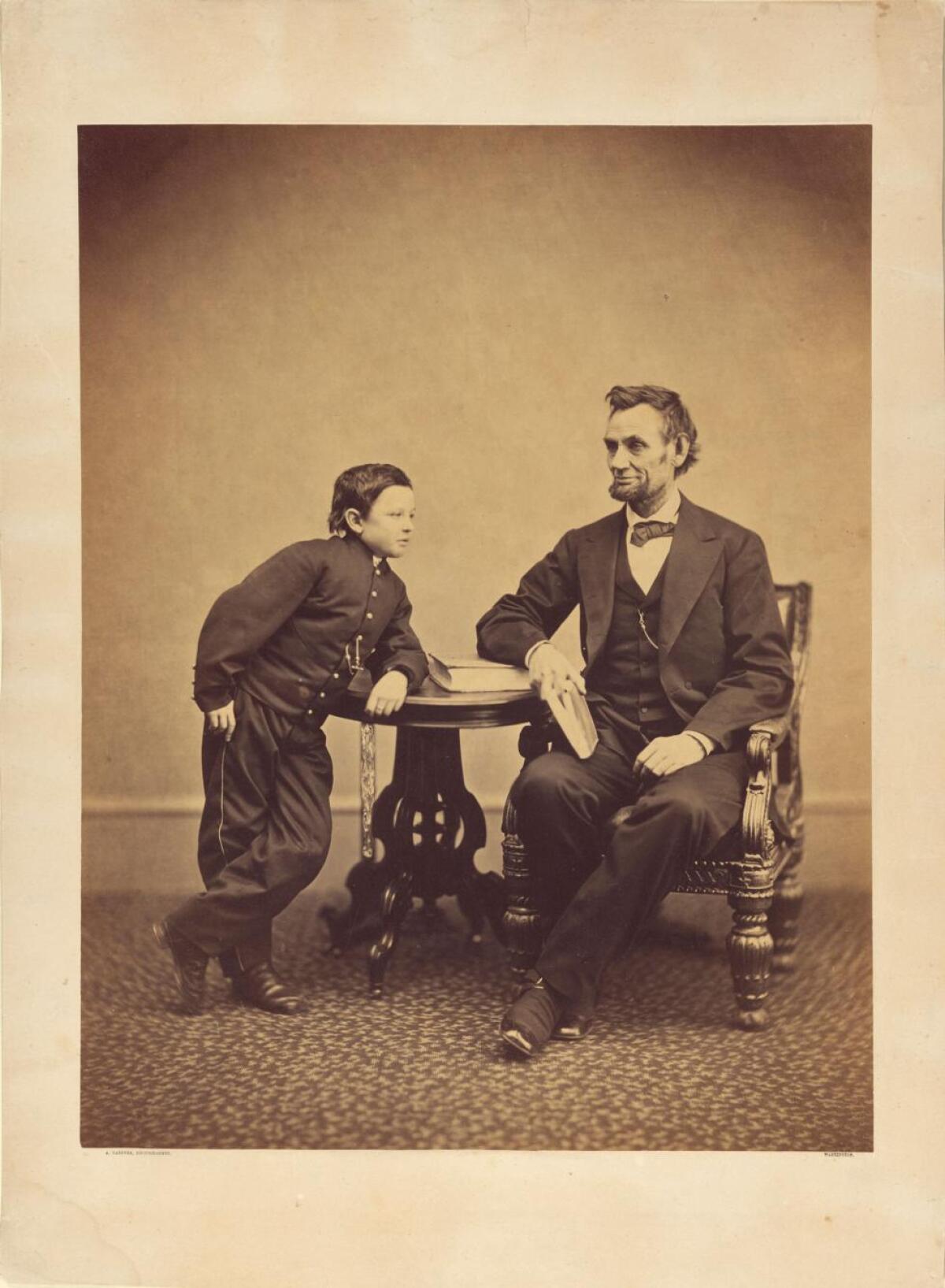
“Cut! Paper Play in Contemporary Photography,” at the Getty Museum. Another photography-related exhibition at the Getty looks at the medium’s intersection with cut paper. This includes cut-paper models that are then photographed, and photographic images that are collaged into three-dimensional pieces. Through May 27. 1200 Getty Center Drive, Brentwood, Los Angeles, getty.edu.
“Tony DeLap: A Retrospective,” at the Laguna Art Museum. The museum has put together a retrospective dedicated to the Southern California finish/fetish artist who has explored color, form and minimalism in a career that has spanned more than six decades. The show features an estimated 80 paintings, sculptures and drawings — and an accompanying catalog tracks the arc of his career. Through May 28, 307 Cliff Drive, Laguna Beach, lagunaartmuseum.org.
Charles Christopher Hill, “Origin Story,” at Leslie Sacks Gallery. Hill, a member of the L.A. arts scene of the 1970s, puts together materials such as fabric, paper, newsprint and thread to create collaged, abstract works that ride the dividing line between painting and textile. This show will gather key works from the ’70s and ’80s. Through June 2. Bergamot Station, 2525 Michigan Ave., No. B6, Santa Monica, lesliesacks.com.
“Testament of the Spirit: Paintings by Eduardo Carrillo,” at the Pasadena Museum of California Art. A solo exhibition devoted to the Los Angeles painter and educator examines his legacy and work. The show includes the exhibition of a celebrated mural, “Chicano History,” which Carrillo painted with Sergio Hernandez, Ramses Noriega and Saul Solache, and which is on view for the first time since 1991. The museum has also unveiled two other exhibitions: “The Feminine Sublime,” a group show that takes ideas of the sublime, generally depicted from a male point of view, and gives it a decidedly feminine twist, as well as an installation by Ana Serrano, who is creating an immersive “garden” out of simple art materials such as cardboard, paper and paint. Through June 3. 490 E. Union St., Pasadena, pmcaonline.org.
“In Conversation: Alma Allen & J.B. Blunk,” at the Palm Springs Art Museum. This exhibition puts together the work of two key artists from two generations working with natural materials such as stone, wood and metal. J.B. Blunk, who died in 2002, began making work in the ’60s inspired by organic and anthropomorphic forms. Allen, a contemporary artist, quite similarly works in metal and wood and is inspired by nature’s shapes and textures. Both have created functional objects (such as elements of their homes) as well as sculptures that are experimental and abstract. Through June 4. 300 S. Palm Canyon Drive, Palm Springs, psmuseum.org.
Mark Ruwedel, “Rivers Run Through It,” at Gallery Luisotti. For decades, Ruwedel has focused on capturing pieces of infrastructure and nature. In this latest series, the artist focuses on the perfect union of the two: the Los Angeles River and its tributaries. In these images he captures wild nature, but also the firm imprint of man. Through June 9. Bergamot Station, 2525 Michigan Ave., No. A2, Santa Monica, galleryluisotti.com.
“Winds From Fusang: Mexico and China in the Twentieth Century,” at the USC Pacific Asia Museum. This is the first major exhibition to look at a key trans-Pacific cross-pollination: the influence of Mexican art on the development of art in China in the 20th century. This includes an examination of the period in the 1930s that Mexican artist Miguel Covarrubias spent in Shanghai, and a look at a subsequent era, from the 1950s to the ’70s, when works by key Mexican artists were presented in China. The show, part of PST: LA/LA, is a grand reopening for the museum following a seismic retrofit. Through June 10. 46 N. Los Robles Ave., Pasadena, pacificasiamuseum.usc.edu.
“Rodriguez/Valadez in Vernon,” at Fine Art Solutions. This two-painter show brings together work by L.A. painters Sandy Rodriguez and John Valadez, whose views of the city are often infused with dark humor — and just a little touch of the magical. Rodriguez also makes wry paper works that riff on painted colonial and pre-Columbian codices in contemporary ways. Through June 16. 3463 E. 26th St., Vernon, fineartssolutionsinc.com.
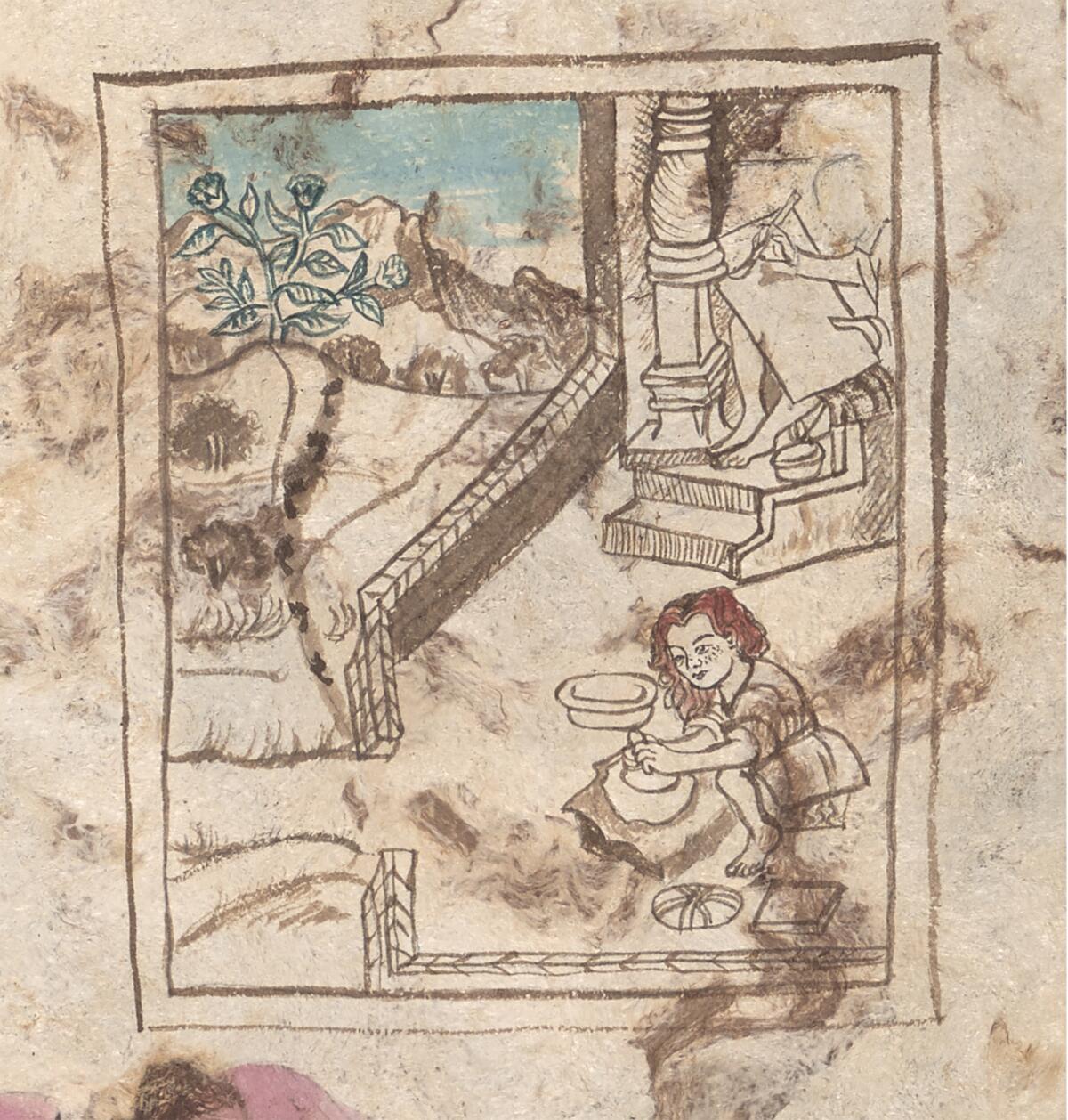
Gilbert “Magu” Luján, “Recuerdos del Futuro: Roaming Magu’s Chicano Dreams,” at La Plaza de Cultura y Artes. This show on the late artist, a founding member of the influential collective Los Four, gathers 81 works — including paintings, drawings and sculpture — that tracks the ways in which he employed quotidian imagery to channel a Chicano futurist vibe. Embedded in his paintings and surreal installations were images of graffiti, lowriders, dogs and elements of the rasquache (or lowbrow). As part of the show, two contemporary artists — calligraphy artist JERK and printmaker Daniel Gonzalez — created work in dialogue with Magu. Through June 25. 501 N. Main St., downtown Los Angeles, lapca.org.
Reena Spaulings, “The Male Gates,” at Matthew Marks Gallery. The artist collective (which also operates a gallery by the same name) has a new show at Matthew Marks that consists of paintings on canvas and walk-through security gates (the sort you find at airports and nightclubs and some museums). Also on view are three new marble sculptures, including one made from the same blue stone employed by Modernist architect Adolf Loos in the Semler House in the Czech Republic. Through June 30. 1062 N. Orange Grove, West Hollywood, matthewmarks.com.
Meleko Mokgosi, “Bread, Butter, and Power,” at the Fowler Museum. Mokgosi first drew wide attention in Los Angeles when he won the $100,000 inaugural Mohn Prize at the Hammer Museum’s “Made in L.A.” biennial in 2012. Now he’s back with a large-scale painting exhibition at the Fowler — a 20-panel installation that looks at how democratic concepts infuse aspects of daily life, down to love and relationships. Through July 1. 308 Charles E. Young Drive North, Westwood, Los Angeles, fowler.ucla.edu.
“Soul Mining,” at the Vincent Price Art Museum. A new group show examines the influence Asian immigrants have had on the economics and the culture of Latin America. Some of this connects with the anti-immigration histories of the U.S.: when the Chinese Exclusion Act was signed into law in 1882, Chinese laborers expelled from the U.S. moved on to Latin America, having a profound effect on the continent’s social, political and cultural landscapes. Also on view are works from the L.A. County Museum of Art’s permanent collection: the Mexico photographs of Mariana Yampolsky and objects from the museum’s holdings of ancient Egyptian art. Through July 14. East Los Angeles College, 1301 Cesar Chavez Ave., Monterey Park, vincentpriceartmuseum.org.
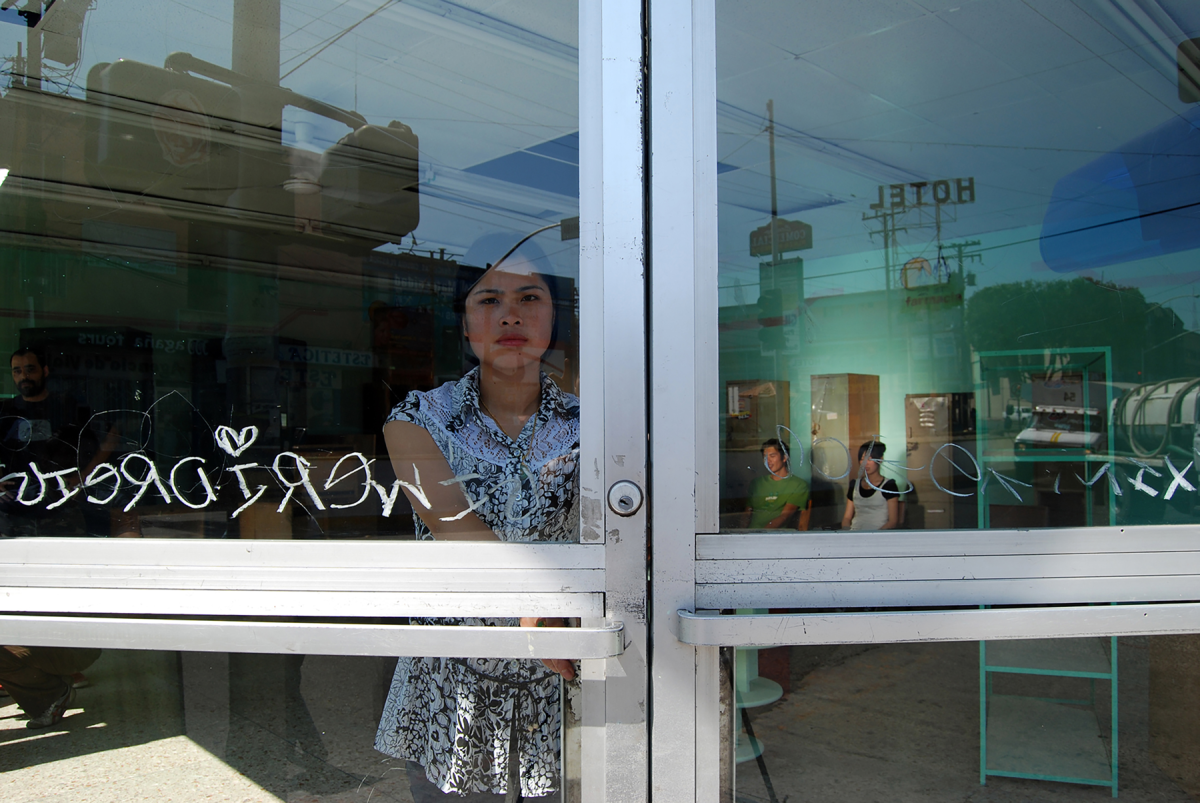
Rafa Esparza, “de la Calle,” at the Institute of Contemporary Art Los Angeles. The Los Angeles artist is transforming the museum project room into a stage for collective works that explore issues of migration and colonization. Esparza and his collaborators will produce an artist book over the course of the exhibition and also stage a performance in Santee Alley. Through July 15. 1717 E. 7th St., downtown Los Angeles, theicala.org.
Leopoldo Peña, “Pelotas Oaxaqueñas/Oaxacan Ball Games,” at the Fowler Museum. For five years beginning in 2011, the L.A.-based painter documented the traditional games played by California’s Oaxacan immigrant community. The games includes the centuries-old pelota mixteca (Mixtec-style ball) and variant called pelota de esponja (sponge ball), both played with decorated mitts that combine indigenous design with contemporary logos. The games, which often take place in empty lots around the San Fernando Valley, are fast-paced affairs that serve as important social gatherings. Through July 15. 308 Charles E. Young Drive North, Westwood, Los Angeles, fowler.ucla.edu.
“City and Cosmos: The Arts of Teotihuacan,” at the Los Angeles County Museum of Art. In its day, the ancient city of Teotihuacan was the largest urban center in the Americas — and the sixth-largest city in the world. Today, it is an iconic Mexican archaeological site. This exhibition presents recent findings from excavations at the site’s three main pyramids. It includes more than 200 objects that help tell the story of the ancient city, including monumental sculpture and smaller-scale objects that include precious stones. Through July 15. 5905 Wilshire Blvd., Mid-Wilshire, Los Angeles, lacma.org.
“Extracorporeal,” at the Museum of Latin American Art. Inspired by the art of the late Cuban American artist Ana Mendieta, whose actions and photographs explored violence, place and the body, “Extracorporeal” gathers works by four U.S. and Latin American artists whose work also operates in that vein. This includes sculpture, video and performance by Antonio Paucar, Daniela Rojas, Roberto Tondopó and the L.A.-based Carmen Argote. Through July 29. 628 Alamitos Ave., Long Beach, molaa.org.

“Gary Simmons: Fade to Black,” at the California African American Museum. In a lobby installation — one that takes full advantage of its size and scale — Simmons pays tribute to forgotten African American actors and films. On a black background, the L.A. artist features the titles and names of films and individuals important to the early days of Hollywood history, but forgotten over time. Through July 2018. 600 State Drive, Exposition Park, Los Angeles, caamuseum.org.
Harry Gamboa Jr., “Chicano Male Unbonded,” at the Autry Museum of the American West. For years, Gamboa has photographed Chicano men — often figures with whom he has a personal relationship — at night in the dark from a low angle, giving his figures an imposing authority. This exhibition gathers more than 80 of those images into a single-room installation: scholars, artists, musicians, thinkers, photographers and even the artist’s dad, a printer — collectively calling into question the general public’s (not to mention our president’s) stereotyped view of Mexican American men. Through Aug. 5. 4700 Western Heritage Way, Griffith Park, Los Angeles, theautry.org.
Adler Guerrier, “Conditions and Forms for blck Longevity,” at California African American Museum. The Haitian artist is the subject of a solo exhibition at the museum that explores the nature of domestic gardens and other outdoor spaces as mini-utopias. This project looks at spaces in Miami and L.A. where black life takes place in sheltered, protected ways. Through Aug. 26. 600 State Drive, Exposition Park, Los Angeles, caamuseum.org.
Olafur Eliasson, “Reality Projector,” at the Marciano Art Foundation. Eliasson has created an environmental installation for the foundation’s first floor Theater Gallery that combines sculpture, painting, photography and film. The piece works with the former Masonic Temple’s existing architecture to create a play on forms and shadows. It’s an installation that Times art critic Christopher Knight describes as “eye-grabbingly vivid.” Through August. 4357 Wilshire Blvd., Windsor Square, Los Angeles, marcianoartfoundation.org.
Sadie Barnette, “Dear 1968, ...” at the Museum of Contemporary Art San Diego. Barnette and her family recently obtained the 500-page file the FBI had amassed on her father during his time in the Black Panthers. The artist employs documents from the file along with other family objects as a point of inspiration for an installation that explores the intersection of the personal and the political in dramatic ways. Through Sept. 2. 1100 Kettner Blvd., San Diego, mcasd.org.
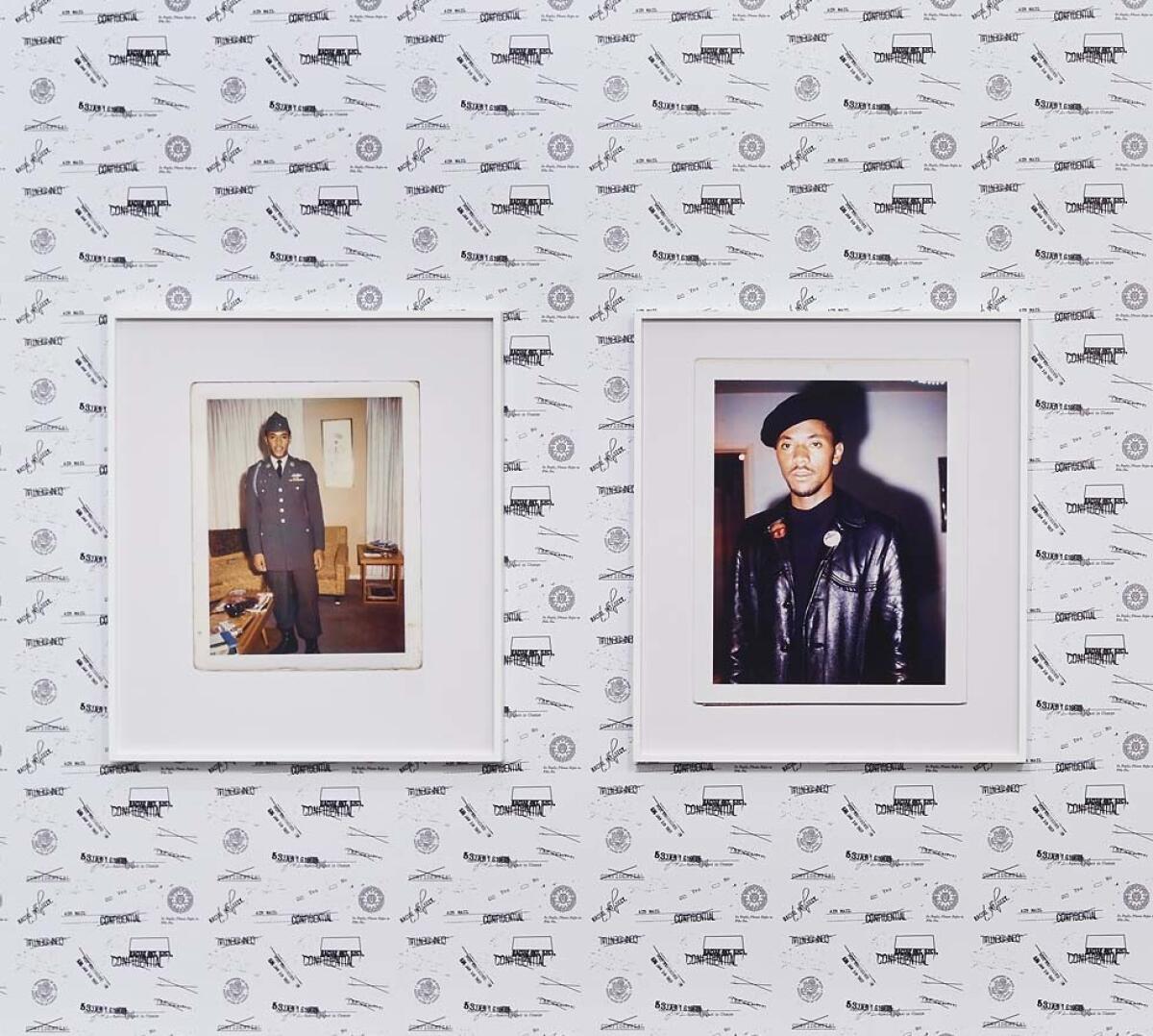
Lauren Halsey, “we still here, there” at the Museum of Contemporary Art. The artist has taken up residence at the museum’s Grand Avenue location, where she is building a fantastical immersive environment that will evolve over time. Through Sept. 3. MOCA Grand Avenue, 250 S. Grand Ave., downtown Los Angeles, moca.org.
Shinique Smith, “Refuge,” at California African American Museum. The multimedia artist is known for her bulbous assemblages crafted from old clothing and fabric, which she twists and ties and suspends from gallery ceilings and walls. Her paintings echo these bound and squeezed forms. Her first solo show at CAAM brings together works that evoke questions of homelessness and itinerancy. Through Sept. 9. 600 State Drive, Exposition Park, Los Angeles, caamuseum.org.
“Charting the Terrain: Eric Mack and Pamela Smith Hudson” at the California African American Museum. A pair of artists explore aspects of Western landscape through abstraction. In his work, Mack creates intricate compositions that echo aspects of movement and the urban grid, while Hudson’s works evoke the topographic — mapping devastation and rejuvenation. Through Sept. 9. 600 State Drive, Exposition Park, Los Angeles, caamuseum.org.
“Beyond the Nile: Egypt and the Classical World,” at the Getty Museum. This exhibition at the Getty explores the cultural connections between Greece, Rome and Egypt through more than 200 rare objects — many on view in the U.S. for the first time. The show spans more than 2,000 years, from the Bronze Age to the late Roman Empire and includes stone vessels, pottery, sculpture, portraits and religious imagery. It also includes a more than 15-foot granite obelisk from A.D. 88-89 inscribed to the goddess Isis and the emperor Domitian, on loan from the Museo del Sannio in Italy. Through Sept. 9. 1200 Getty Center Dr., Brentwood, Los Angeles, getty.edu.

“Discovering Saar Ceramics,” at the American Museum of Ceramic Art. In 1949, artist Richard Saar and his brother William opened a ceramic studio in a small Quonset hut in El Segundo. Saar Ceramics, at its height, would go on to employ a staff of eight, and produce functional and decorative pieces with elegantly rendered abstract designs and charming animal figures. Does the name sound familiar? Well, Saar was, for a time, married to key Los Angeles assemblagist Betye Saar in the 1950s and ’60s. Through Sept. 16. 399 N. Garey Ave., Pomona, amoca.org.
“The Archival Impulse: 40 Years at LACE,” at Los Angeles Contemporary Exhibitions. LACE, the historic Los Angeles art spot that gave key shows to Mike Kelley and groups such as Survival Research Laboratories in the ’80s, is turning 40 — and to mark the occasion, the organization has been poking around its metaphorical attic (aka its archive) to see what it might turn up. This show gathers elements from that archive as well as video works by a range of Los Angeles artists, including Jim Shaw, Susan Mogul and Reza Abdoh. Through December. 6522 Hollywood Blvd., Hollywood, welcometolace.org.
“La Raza,” at the Autry Museum of the American West. In its day, the civil rights publication La Raza, which was based in Lincoln Heights, served as a bible for the Chicano movement, covering protest, policy and everyday life for the Mexican American communities of Los Angeles. Over the years, the paper amassed an archive of 25,000 images, recently digitized by the Chicano Studies Research Center. Many are now on view as part of this PST: LA/LA show at the Autry — and in a time of political strife surrounding the issues of civil rights, this exhibition couldn’t be more timely. Through Feb. 10, 2019. 4700 Western Heritage Way, Griffith Park, Los Angeles, theautry.org.
“L.A. Communities Through the Eyes of Artists,” in the Passageway Gallery at Union Station. For 15 years, L.A.’s principal train station has been showcasing work that reveals the city through the eyes of its artists. This year, it is showing a series of newly commissioned pieces — including Shizu Saldamando’s depiction of Little Tokyo, Sam Pace on Leimert Park and Artemio Rodriguez on East L.A. On long-term view; no closing date set. Union Station, 800 N. Alameda St., downtown Los Angeles, metro.net.
Alejandro G. Iñárritu, “Carne y Arena,” at LACMA. The gripping new virtual reality experience by the Academy Award-winning director places the participant in the shoes of migrants making the arduous trek through the Sonoran Desert to reach the United States. This may sound like the trivialization of what can be a fatal journey, but it is not. Iñárritu has considered all the elements that surround his virtual reality video to humanize the story of immigration on the U.S.-Mexico border. I wrote about my experience of the piece in June. It’s not cheap (a $30 special admission, in addition to regular museum fees) but it’s worth every penny. On long-term view; no closing date set. 5905 Wilshire Blvd., mid-Wilshire, Los Angeles, lacma.org.
Daniel Hawkins, “Desert Lighthouse.” The Los Angeles-based artist is obsessed with producing works that toy with ideas of grandiosity, failure and gestures that border on the Sisyphean. (One of his goals as an artist is to ultimately build a scale replica of the Hoover Dam.) Now Hawkins has installed a 50-foot tall, fully functioning lighthouse in the Mojave Desert in the vicinity of Barstow. The piece even features a light to guide travelers through this rugged landscape. Directions and coordinates can be found on the website. On long-term view, Hinkley, Calif., desertlighthouse.org.
Sign up for our weekly Essential Arts & Culture newsletter »
Twitter: @cmonstah
The biggest entertainment stories
Get our big stories about Hollywood, film, television, music, arts, culture and more right in your inbox as soon as they publish.
You may occasionally receive promotional content from the Los Angeles Times.








